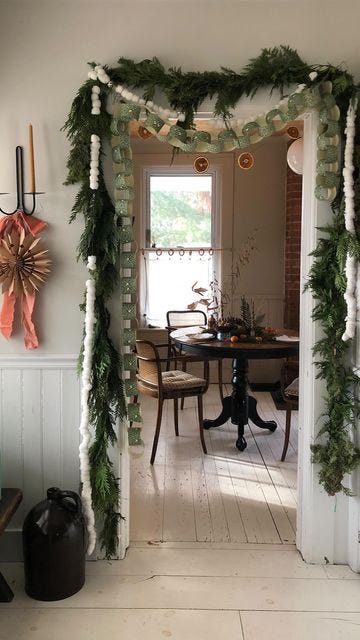Perhaps even more than decorating for fall, decorating for winter holidays can feel a stressful, materialistic project. If this is not the case for you, thank goodness! I am glad. However, in response and protest, I fear, we at times say ‘no’ to any effort to bring seasonal beauty into our homes. The aisles of faux tress and garlands erected after Halloween send some of us into a cynical stupor. A few others find the displays magical—still connected to their inner-childlikeness—but slightly overwhelming. Another group of us will agonize over health concerns related to all Christmas decor—even fresh things! How to respond to our culture’s strange relationship with holidays…
What I’ve found refreshing and encouraging lately is this: Decorating for the seasons is an old, old art. Rather than giving into the rush or rejecting it, an intuitive and perhaps more life-giving response might be to delve into the rich heritage that surrounds these seasons of darkness and light. Timeless “decor” arose from need, from spiritual or religious observance, and some arose because the natural crafts of summer called for winter alternatives. People didn’t decorate; they lived fully.
The post-modern life of the interior, on the other hand, is an increasingly superficialized one in which our consciousness of the deep patterns of human living hardly exists. With furnaces to heat our homes, there’s no need to source wood, chop it, and bring it inside. With electricity and gas fuel, we can stay up as late as we like, and use candles for fragrance rather than light. With a growing indifference to the rhythms of religious life, Halloween, Christmas, Thanksgiving, and New Years (to name the token holidays) are mere social gatherings—opportunities for indulgence and aesthetic experience. (Non-Christian feasts are also at risk of this, I would guess, but I have little firsthand experience.) We’ve lost consciousness of our roots.
We need not be surprised, then, when these holidays feel burdensome and tiresome. Our present culture is not set up for them to be otherwise, I’m afraid.
But we hold within us a deeper sense of culture as well.
For the hundreds of years (I believe we might even say thousands.) that people have been putting up trees and decorating with evergreen foliage during the winter months, building towers of wood for their fires, burning candles to light their morning work and evening prayers, cooking and baking to nourish and sustain, these chores were the things they did. Rather than added onto a flurry of work, busyness, running errands, and online shopping, what we consider peripheral “decorating” and “styling” were the main event. Life depended on them.
How can we, then, strip back the fluff, the rootless traditions created by our economy and secular culture—those that would suggest we can exist without depending on things and on each other, on God—and re-assert the simple, the human, and the holy?
First, we can acknowledge the unnecessary and contrived that has come to seem expected and required. (I might suggest that a lot of Christmas decorating falls into this category.) Next, which traditions and materials have real heritage within our families and their stories? Where are gifts of the religions we were raised in? And what kinds of plants grow around our homes in wintertime? Authentic and meaningful holiday decorating starts here in the intimacy of our houses, our histories, and our land.
To get practical in crafting a more integrated, humane winter interior—try sourcing fresh greens for your wreaths and garlands—and a living tree if you can. The journey of going to collect them can be a fun, communal affair. There are few things as satisfying as choosing real and natural over plastic and pre-made.
Where I live in the American Midwest, we can purchase trees and greens from Christmas tree farms (not as real as going out into the wild woods like I did as a child in the Rocky Mountains—but something). There are also plenty of coniferous trees about. I count this as a real gift and try not to take it for granted. Wreaths can be made with grapevine wreaths or metal bases, twine or floral wire, and scrap greens from garlands and tree clippings. You’ll need ribbon or fabric to hang them up, and there you can incorporate the colors and patterns that encourage you this time of year. (Here’s one of many helpful tutorials.) Fresh greens can go everywhere: the mantle, bookshelves, draped on curtain rods, above windows, in vases. (Here are tips for keeping them fresh.)
To accent—If red berries grow where you live, add those in, or string some cranberries and drape those as well. Although we can get oranges year-round now, they were once a winter delicacy in northern climates, providentially offering helpful nutrients for the cold, house-bound months. Dry these at a low oven temp and then use them as ornaments or placed atop winter greens. Star anise, cinnamon sticks, and cloves are other natural (and seasonally relevant, as they offer support to the immune system) accents. These as well as dried and preserved plants can be reused year after year.
The only artifacts really needed, I think, center around the spiritual roots of this season: the coming of the divine, who is goodness and light. Out of the depths of winter’s dark, there is suddenly a turn. Our experience of this as humans remains one of our most profound, our most essential. Whether in the form of a creche, a menorah, or other, we need some substantial reminder that we are accompanied especially through the night.
Paring back, looking back, I hope we find some peace and beauty as we prepare for these holy days. Decorating richly and authentically is not so much about rejecting what our post-modern culture gives us but rather remembering what we have forgotten.





